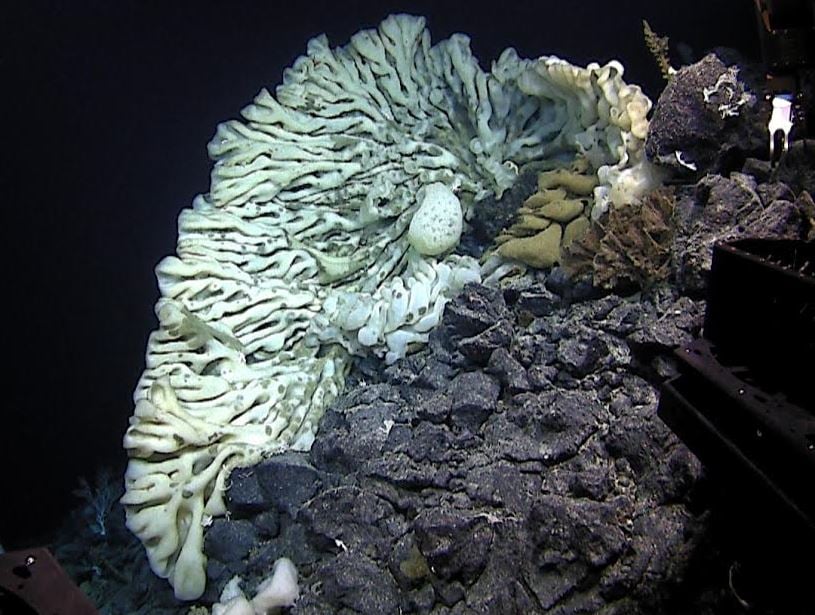A giant sponge the size of a minivan – the world’s largest – was discovered in the summer of last year by a team of scientists during a deep-sea expedition in Papahānaumokuākea Marine National Monument, a World Heritage listed area of Northwestern Hawaii.
The scientists had been surveying an ocean ridge in the marine conservation area when they came across something surprising.
 A photograph of the giant sponge, the largest on record, found summer last year during a deep-sea expedition in Papahānaumokuākea Marine National Monument off Hawaii. (Image: noaa.gov)
A photograph of the giant sponge, the largest on record, found summer last year during a deep-sea expedition in Papahānaumokuākea Marine National Monument off Hawaii. (Image: noaa.gov)
Giant sponge deep down surprised researchers
The 12 foot by 7 foot giant sponge – a live animal – was discovered 7,000 feet down. The rare bluish-white sponge, which looks a bit like a giant brain, stunned scientists when it appeared in the remote cameras of their underwater rover.
Daniel Wagner, who works at the NOAA Papahānaumokuākea Marine National Monument, and Christopher D. Kelley, from the University of Hawaii at Mānoa, describe the massive creature in the scientific journal Marine Biodiversity.
According to Associate Professor Kelley, program biologist at the Hawaii Undersea Research Lab (HURL) and associate professor of Oceanography, during the expedition aboard NOAA Ship Okeanos Explorer, the team captured images of the sponge with remote underwater cameras that had been fixed onto their underwater research rovers.
Expedition leader, Dr. Wagner, a Papahānaumokuākea research specialist, said:
“The largest portion of our planet lies in deep waters, the vast majority of which has never been explored. Finding such an enormous and presumably old sponge emphasizes how much can be learned from studying deep and pristine environments such as those found in the remote Papahānaumokuākea Marine National Monument.”
 The huge sponge photographed at a depth of 2117 metres in the Papahānaumokuākea Marine National Monument by (a) the ROV Deep Discoverer and (b) its companion ROV Seirios. (Image: Marine Biodiversity)
The huge sponge photographed at a depth of 2117 metres in the Papahānaumokuākea Marine National Monument by (a) the ROV Deep Discoverer and (b) its companion ROV Seirios. (Image: Marine Biodiversity)
With the use of laser points they measured parts of the sponge and the vehicle, and were able to calculate the size of the underwater creature.
Sponges like coral reefs provide critical habitat for other sea life and filter huge amounts of seawater and remove material that most marine animals do not eat.
Scientists say that some of the large sponges that have been found in shallower waters are more than 2,300 years old. They wonder how old these huge deep-sea organisms – that have never been observed before – can be.
In the journal article, the authors wrote:
“While not much is known about the lifespan of sponges, some massive species found in shallow waters (<30 m) are estimated to live for more than 2300 years.”
“Finally, the finding of such a large organism as that reported here highlights the value of using deep-diving technologies in surveying the deepest parts of our oceans, which remain largely unexplored.”
What are sponges?
They may look like plants, but they are not – sponges (Porifera) are the simplest of multi-cellular animals. They are bottom-dwelling creatures that attach themselves to something solid where they can hopefully get enough food to grow.
As their Latin name implies – Porifera means ‘pore-bearing’ – sponges are covered in tiny pores called ostia, which lead internally to a system of canals and eventually out to one of the bigger holes called oscula.
 The water carries nutrients and oxygen into the sponge through the ostia (small holes), and leave the animal carrying carbon dioxide and waste also through the little holes. (Image: oceanicresearch.org)
The water carries nutrients and oxygen into the sponge through the ostia (small holes), and leave the animal carrying carbon dioxide and waste also through the little holes. (Image: oceanicresearch.org)
The sponge’s canals have chambers lined with specialized cells called choanocytes, or collar cells. These collar cells have a hairlike whip called a flagellum, and a sticky, funnel shaped collar.
The collar cells beat their flagella back and forth to force water – which carries nutrients and oxygen – through the sponge. The flowing water carries waste and carbon dioxide out of the animal.
When the water flows into the sponge, the sticky collars of the collar cells grab bits of food. An amebocyte, another type of cell, takes the food to other cells within the sponge.
Sponges are master filter-feeders – they can capture and eat particles as tiny as bacteria as well as much bigger particles.
The sponge’s ‘skeleton’ consists of tiny spicules (needle-like splinters), a mash of protein called sponging, or a combination of the two.
The majority of sponges are hermaphroditic – both male and female in one – but produce only one kind of gamete per spawn, i.e. while some play the male role others play the female role, even though they are both male and female.
Our oceans are full of many different types of sponges, which can be quite beautiful and colourful.
Sponges come in two basic kinds: free-standing or encrusting. The encrusting ones cover the surface of a rock in the same way that moss does on land.
Sea sponges are commonly used by humans as a luxurious, natural alternative for bathing and cosmetics. They are also useful for cleaning all kinds of things, as well as pet bathing, exfoliation, car washing, water colour painting, photography props, first aid, and dish washing.
Video – World’s largest sponge
In this New Scientist video, you can hear the surprise in the scientists’ voices when they see the giant sponge for the first time.
